Types of staircases vary but one thing is for sure: A staircase is an integral part of any home that has more than one level. For a construction or remodeling project, the type of staircase you choose is also a very important consideration. It provides specific kinds of visual appeal and takes up varying amounts of space in your home.
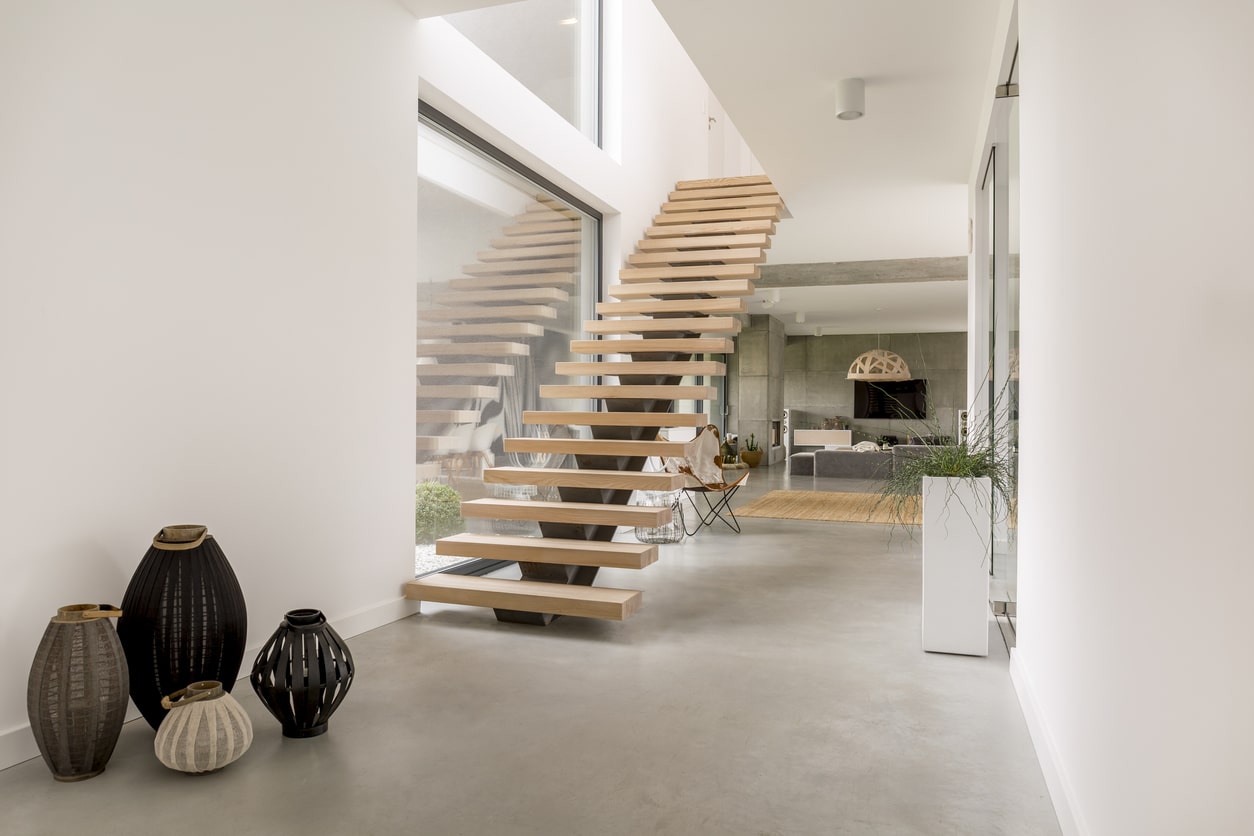
When considering a new staircase, think about your family members and how they use the stairs. Each kind has advantages and disadvantages, so consider these to make the best choice.
Parts of a Staircase
Before choosing between types of staircases, it’s important to know all the different parts of a staircase. This lets you pick specific characteristics of designs that appeal to you.

Styles will look very different, but the names of the parts are all the same.
Tread
When your foot hits the stair, the part you step on is called the tread, This horizontal part goes from the front edge to the riser at the back. Each region has its own residential building codes, however, in most cases, the tread must be a minimum of 11 inches deep.
Risers
The vertical part of the stair between each step is called the riser. Generally, staircases that have these are called closed tread stairs.
In contemporary and more modern constructions, staircases don’t have them. This style is called the open riser variety. Residential codes usually require that risers be no more than 7 inches high and no less than 4 inches. For open riser stairs, the gap where the riser would go cannot be more than 4 inches.
Stringers
The zig-zag support that goes up each side of the stairs is called the stair stringer. This piece holds the treads and risers in place. One of the stringers is against the wall and the other is on the open side of the staircase.
Handrail
Sometimes called a banister, the handrail is the part you hold while climbing up and down the stairs. The handrail is fixed to vertical posts (balusters) or a wall up one or both sides of the staircase.
Guardrail
This is the barrier that protects the side of the stairs that is open. Its main purpose is to keep people from falling.
Baluster
These days, most people call a baluster a spindle. These are the vertical poles that connect that handrail to the treads, acting as the guardrail.
Balustrade
Collectively, all those spindles — or balusters — are called the balustrade. This is the full, open and decorative side of the staircase.
Newel Post
A larger, heavier post sits at each end of the handrail. This is called the newel post. If the staircase has a turn, that point may also have a newel post. This gives the balustrade stability because it attaches to the floor or the stringer.
Base Rail
At the base of the guardrail, a board runs atop the string but under the balusters. This is called the base rail. The newel post supports it at each end.
Fascia
This is a purely decorative board that board used on the outer side of the stairs. It often covers the side of the risers but it can also cover a gap between the floor of a balcony and the ceiling underneath.
Landing
This is the larger area at the top and bottom of the staircase. The landing is a resting spot at each end of the stairs and is the entryway to the room beyond. Stairs that turn will also have a landing at that location.
Bullnose
Generally, residential stairs will have a bullnose and in some locations, the codes require it. The bullnose is treated as part of the tread and is an extra strip of wood attached to the edge of the tread. These make the individual steps safer and more visible.
Curtail
Often, at the bottom of the staircase, a larger step extends around the newel post. This decorative feature is often found on the side of the stairs that are not against a wall.
Winders
These triangular steps are often used to create a turn in the staircase. You may know these best from spiral staircases, which have lots of them. These pie-shaped steps eliminate the need for a landing.
Gooseneck
When a staircase makes a turn, one handrail will be higher than the other. The gooseneck is the section of the handrail that curves up to join one section of the balustrade with the other.
Volute
The volute is the fancy part of the handrail at the bottom of the staircase. Sometimes called a monkey’s tail, this is the spiral that ends the handrail and is typically used with a curtail.
Small Space Stairs Design
Staircase designs have to get creative in small spaces. Often, in a tiny house on wheels like this one, the type of staircase you consider need to include some storage space.
While it might be more common to have enclosed cupboards under the stairs some tight spaces need a ladder-like stair. In this case, the extra-deep treads offer shelving in the dead space behind the ladder.
Modern Staircase Design
Today’s modern staircases range quite widely in terms of style and materials. While this modern staircase design is a fresh take on a traditional staircase, you’ll find all kinds of options.
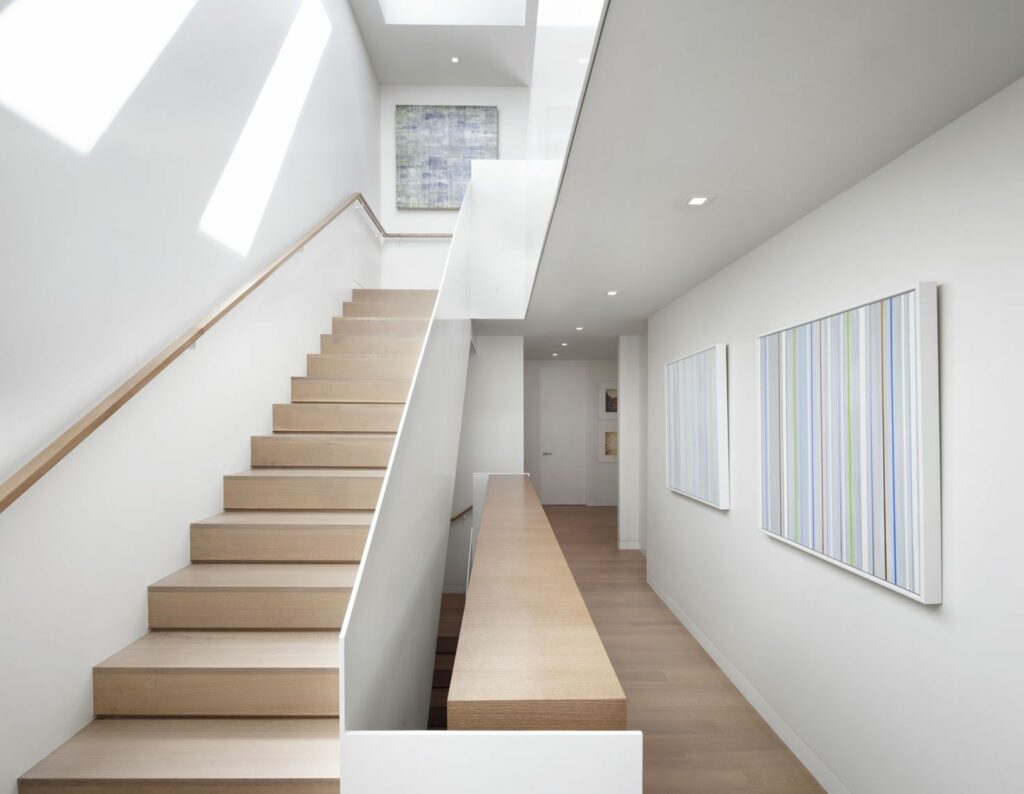
From floating and cantilevered treads to glass panels replacing the traditional balustrades, the choices are unique. You can also find a great variety of materials in modern staircase design, ranging from metal, wire and glass to concrete, bamboo and custom wood creations.
Modern Spiral Staircase
Besides being a major design feature, a modern spiral staircase is a real space saver. In fact, spiral staircases were invented specifically to save space.

The amount of square footage these require is a fraction of what a straight staircase needs. This is especially true because the upper end only needs to be an opening in the floor, directly above the base of the stairs.
A modern spiral staircase can be made with a custom spiral around the central pole and full-size treads.
Modern Farmhouse Staircase
With farmhouse décor still being a trend, it’s no wonder that modern farmhouse staircase design evolved into some pretty slick options.
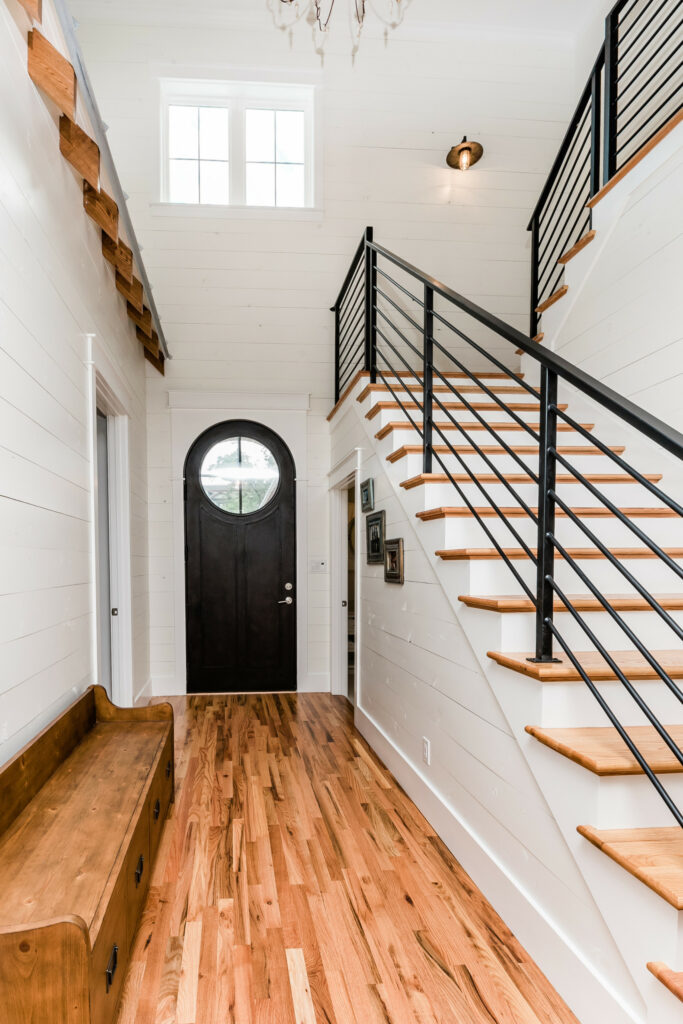
Following the main palette, most of these staircases are done in black, white and natural wood tones. Other features a modern farmhouse staircase usually includes are metal balustrades and railing and natural wood treads.
The trend for having horizontal balusters is popular in this style too.
Modern Glass Staircase
Thanks to the desire for a more open feeling in the home, modern glass staircase design is becoming very common.

Homeowners like these types of stairs because they create a wide-open view with no obstructions. A modern glass staircase also lets light travel throughout the space, making it feel larger. Glass is also one of the easiest surfaces to maintain because there’s no need to paint or stain it.
Moreover, today’s tempered glass is durable and doesn’t crack and break. Finally, it’s pet- and kid-friendly because there are no gaps to slip through or get stuck in.
What Type of Glass for Staircases
As already noted, the glass for staircases is safe, strong and durable.
Generally, there are two types of glass to choose from:
- Tempered glass is made using both thermal and chemical techniques that make to about six times stronger than regular glass. In case of breakage, tempered glass will break into very small blunt-edged pieces, which is why it’s also called safety glass.
- Laminated glass is actually separate layers of glass that are bonded together with polyvinyl butyral resin (PVB). This type of glass for staircases is very popular, especially when combined with tempered glass. In case of breakage, it cracks in a web pattern just like a car windshield does.
Alternating Tread Staircase
Somewhere between a loft ladder and a regular staircase, you’ll find the alternating tread staircase. This type of stair design has room for one foot on a step at a time.

You climb them just like regular stairs, but they are half the width of a typical tread. These are super functional because they are usually combined with shelving or closed storage to maximize space.
They also look very, very cool. Before planning to incorporate this modern staircase design into your home, be sure to check local codes for these types of straight stairs.
What are the different types of staircases?
Here we run down the different types of staircases and the considerations for each one.
- Straight
- L-shaped
- U-shaped
- Winder
- Spiral
- Circular
- Curved
- Ladder
- Split
- Space-Saving
- Floating
- Storage
- Sculptural floating
- Bent metal
- Floating-standalone
- Spiral staircase made of metal
- Spiral staircase with landing
- Stairs and bookshelves
- Concrete
- Organic
- Graphical iron
- Two-tone spiral
Straight Stairs

A straight staircase is the most common and affordable style available. Pre-cut risers — the vertical part of the staircase — are available in lumber yards home stores. Many builders use these because of their simplicity.
The straight-line design means that the staircase doesn’t need any special structural support. It only needs to attach at the top and the bottom. This type of staircase also allows for easier installation of railings and handrails.
Of course, there are variations of straight stairs. These include open risers, modern materials and metal cable railings that significantly alter the basic look.
While a straight staircase may be the most common, it does have a few drawbacks, namely that it takes up a greater amount of linear space, which can really affect your design.
Straight Stairs with a Central Landing

If you have a tall, high-ceilinged room and are considering a straight staircase that will need to be more than 12 feet high, it will require a central landing. The same is true if your planned staircase has more than the standard number of risers, which is usually 16.
The main drawback of straight stairs with a central landing is the increased amount of space they require, which usually leads designers to choose another style. This type of staircase is generally used in commercial buildings, not private homes.
L-shaped types of staircase
L-shaped stairs are another common style of staircase. They are basically a straight staircase with a half turn, either in the middle or closer to one end or the other. L-shaped stairs are appealing for a variety of reasons, primarily because they are more visually appealing.
In addition, they tend to take up less space and can be used in the corner of a room. For some people, they are also easier to navigate because of the wider flat landing that breaks up the flight of stairs.
Of course, these types of staircases are more complex to build and consequently more expensive. L-shaped staircases also usually require support for the landing and the turn.
U-Shaped Types of Stairs

U-shaped staircases generally consist of two flights of stairs that go in opposite directions with a landing at the switchback. These are also more visually interesting than a straight staircase.
Moreover, they take up less linear floor space and can be handy for a corner design. Typically the landing is of a generous size. The main drawback of a U-shaped staircase is the turn that makes it more difficult to move larger pieces of furniture upstairs.
Winder Types of Stairs
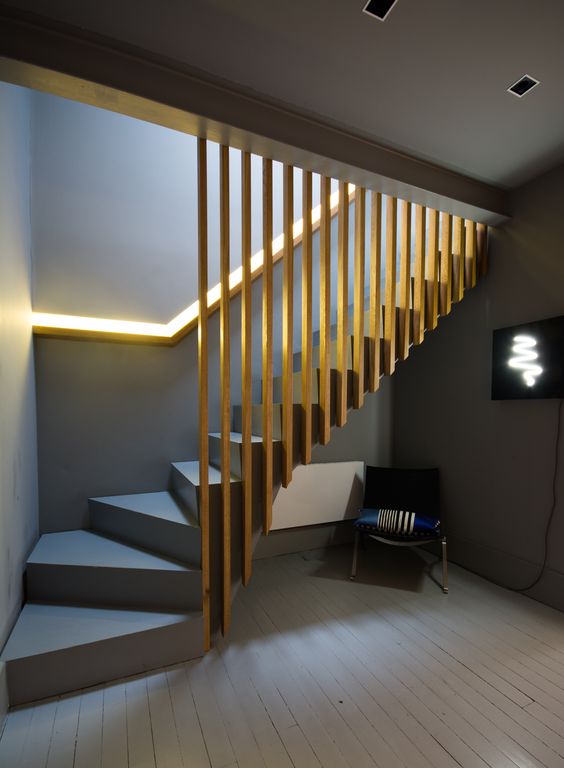
Winder stairs are a lot like an L-shaped staircase, except that there is no landing. Instead, the stairs are continuous, taking on a wedge shape as they make the turn. These are far less common in contemporary homes and are typical of older residences. Rarely were they used as the primary staircase and were more likely the secondary staircase in the home.
This type of staircase is seeing a resurgence in popularity, thanks to the trends that favor smaller and more sustainable homes.
Spiral Stairs

While perfect for tighter spaces, spiral staircases are still considered more of a novelty style. True spiral stairs have one central post. All the radiating steps attach to it as they spiral upward through a space in the floor above. Because of their compact nature, you can typically find them in beach houses and small city dwellings because of the small amount of space they require.
Many city and municipal building codes require that a spiral stair be a secondary route of egress from the higher floor because they are not as easy to navigate.
In fact, that is one of the main drawbacks for spiral stairs: Only one person at a time can use the stairs and footing requires caution because the inner portion of each step is narrow. Besides, it is much harder to move larger items up and down a spiral staircase.
Circular Stairs

A circular staircase is more like a traditional staircase than a spiral one — think of the kind you might find in a medieval castle. While it does go around and the steps are tapered, the curve is more relaxed and the steps are easier to navigate.
Sometimes called helixed stairs, this curved staircase is more graceful and less compact, which helps to create an architectural focal point. Of course, circular stairs require more open space and are costlier to build.
Curved Stairs
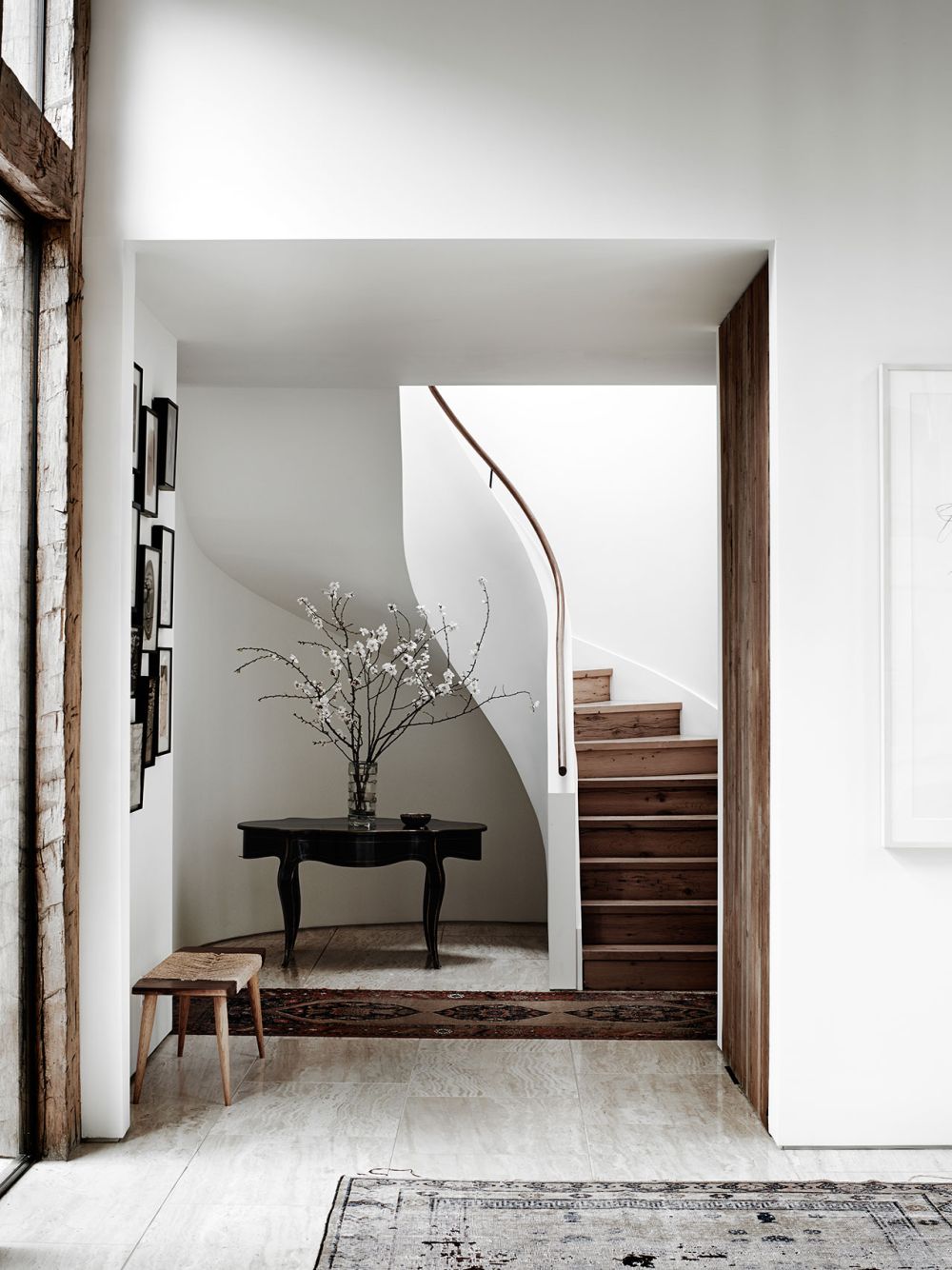
Most commonly used in or near an entryway, a curved staircase is a design statement. They do not form a circle as spiral or circular staircases do. Instead, curved stairs are meant to be a major design feature.
Easy to traverse, the curve is usually gentle and is an elegant choice for any style of home. This type of staircase is said to be the most difficult to construct and, consequently, curved staircases are one of the most expensive.
Ladder Stairs

Great for tight spaces and small residences, ladder staircases are one of the most space-efficient types of staircases. Of course, it’s a good idea to check building codes in the local area because often these types of stairs cannot be the primary staircase.
Ladder stairs can be built in a variety of styles, from a literal ladder-style, as in this photo, to more stylized versions. In any case, ladder stairs will typically have taller steps and can be particularly difficult to climb, especially when coming down the staircase.
This type of stair design can be very handy for other uses, such as for reaching the upper shelves of extensive bookcases or extra tight spaces.
Split Staircase

A split staircase — originally called bifurcated stairs– is the grande dame of all staircases. Typically used in the entryway of a very grand and spacious home, the staircase starts with a wider flight at the bottom.
Part of the way up, there is a generous landing with two parallel flights on either side of the bottom section, one going left and the other going right. Large, expansive and expensive, these types of staircases make a grand entrance — and a big impression.
Space-Saving Staircase

While circular staircases and ladder styles are good for compact homes, there is a wide variety of other styles that are space-saving options for straight staircases.
Stairs that are more steeply pitched, ribbon-style stairs, and narrower, alternating steps are all ways to incorporate a staircase in a home with minimal lost space. As long as the choice meets building codes, the actual style is up to you.
Floating Staircase

Usually a variation on a straight staircase, a floating staircase usually consists of treads with no risers. Instead, the treads in these types of staircase attach to the wall in a way that the support is invisible, or at least minimally visible. Other times, glass or plexiglass risers can achieve a floating appearance.
The material used can be wood, but it is often something else like metal, glass or stone. It is a contemporary look that often foregoes handrails, although you can opt for glass safety without sacrificing the open feeling. Again, any floating style must meet local building codes.
Storage Staircase
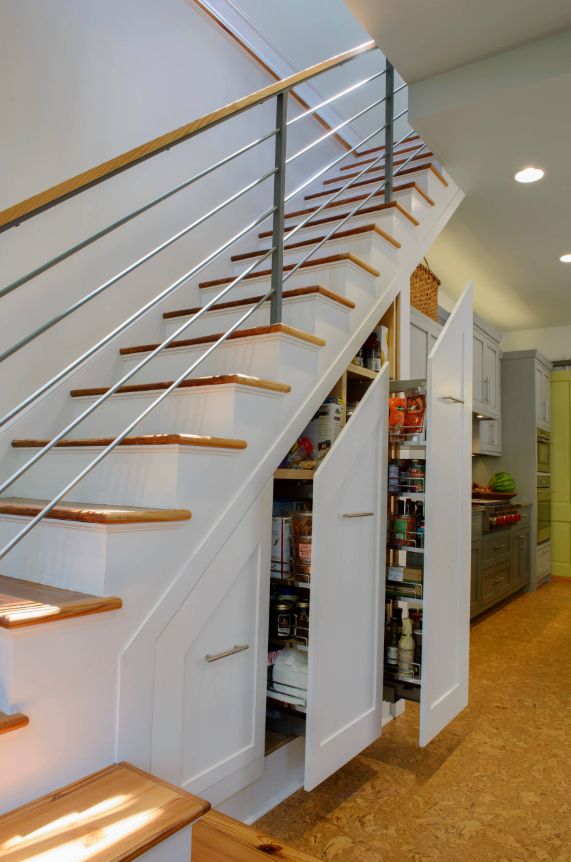
Large or small, almost any home can use more storage and the often-overlooked area underneath the stairs can be turned into valuable space for stashing necessities. The most common way to do this is by building cabinets underneath the risers instead of simply walling off space.
A second way is to turn each riser into a drawer, which is the best option when you can’t make full use of the void underneath the staircase. These types of staircases can really add to the available storage space.
Sculptural floating stairs
This stylish private home by studio Olev places a lot of emphasis on the lighting and the ambiance in each of the rooms. There’s also a very interesting dynamic between all the different spaces and this staircase only makes things more intriguing. The floating straight flight stairs have a minimal and sculptural aesthetic and they’re not leaning against a solid wall but rather going across a glass divider.
Bent metal staircase
If these straight stairs look unusual and intriguing to you that’s because they are. The main question that we all have is what this is made of. It’s so slender and it looks lightweight but also sturdy and durable. The answer reveals it all: bent metal with wooden accents. This is a staircase designed by RUST architects.
Standalone floating stairs
We’ve seen floating stairs before but not like this one. Typically all the steps in these types of staircase connect and form a continuous structure. In this case, they’re all individual freestanding elements.
Each is separately attached to the wall and there’s no safety rail which really emphasizes the sculptural nature of the design. The accent lighting is also a cool detail. This is part of a house in Shanghai designed by Wutopia Lab.
Spiral stairs made of metal
Metal is the go-to material whenever something needs to be super strong and durable but also sleek and slender.
You can see it being put to good use here by depaolidefranceschibaldan architects to create a space-efficient spiral staircase. The dark blue nuance suits it well and looks beautiful in combination with the natural wood used for the steps.
Curved stairs with a flat landing
Not all types of staircases follow a particular style. Some have eclectic designs that combine elements and features from two or more styles. This allows them to better adapt to the space and to serve their function as best as possible. These curved stairs from Depaolidefranceschibaldan Architects is a good example.
Stairs and bookshelves
This beautiful floating staircase is a companion for the bookshelves that stretch all along this wall. It’s a very visually interesting design and is unique among the different types of straight stairs.
As you can see, the shelves also continue upward and some can only be reached from the top of the stairs. It’s definitely a very beautiful, practical and eye-catching combination, one that studio Esrawe came up with.
Concrete stairs
Actually, in interior design, people associate some materials with specific styles. Concrete for example is a trademark of industrial decors but also suits really well a variety of modern and contemporary spaces.
For instance, these types of staircases don’t look as rugged and as harsh as one might imagine. This is especially because they curve around the wall and have this beautiful decorative wall doubling as a railing. This is a space designed by Kristina Lastauskaitė-Pundė.
Organic staircase
This curved staircase is unique and special in more than just one way. It has a very organic, flowing design and it makes use of natural wood which gives it a warm and welcoming look.
It has a sculptural shape and it’s the centerpiece of a beautiful office building.
It’s been outfitted by Paul Cocksedge Studio with a variety of interesting features such as little nooks for reading, drawing, relaxing and drinking tea, thus becoming a sort of social hub for commercial buildings.
with a variety of interesting features such as little nooks for reading, drawing, relaxing and drinking tea, thus becoming a sort of social hub for commercial buildings.
Graphical iron stairs
On the surface, the design of this staircase is also unusual because it’s made from a rather unexpected material: iron. Moreover, also has a very graphic sort of look. It seems like it’s a sketch with only the outlines showing and gaps that are not filled in. The design is meant to look interesting but also to be space-conscious. It must fit into this small living area without being in the way, visually or otherwise. It was all done by Gosplan architects.
Two-tone spiral staircase
Here’s another really cool design, this time by Taller Estilo Arquitectura S de RL de CV. These types of stairs have a sinuous, spiraling shape. It’s space-efficient and gives a graceful appearance. The metal allows it to be slender and have a lightweight appearance. The stairs have an accordion-like shape and they’re black on the underside and chartreuse on the other.
Frequently Asked Questions (FAQ)FAQ
What are the different types of stairs?
In general, these are the different types of stairs:
Straight
L-shaped
U-shaped
Winder
Spiral
Circular
Curved
Ladder
Split
Space-Saving
Floating
Storage
Floating
Bent metal
Organic
Which type of staircase is best?
Determining which type of staircase is best will depend on the style and arrangement of your home. Some types of stairs take up more room than others. Also, various types are more family- and budget-friendly. You’ll have to take into consideration your home, your family and your lifestyle in order to figure out which type of stairs are best for you.
What is the cheapest type of staircase?
Hands down, straight stairs are the simplest and cheapest type of staircase. Stairs that run in a straight line are affordable and easy for builders to install. Tailings and handrails attach easily too. The main drawback to straight stairs is that they take up a lot of linear space.
How to decorate a staircase wall
Most staircases — especially straight, curved and floating — will have a wall that you can decorate. The most common wall decor for a staircase is photographs and artwork. But that’s not all you can do. You could create a display of wall-mounted items like baskets, use statement wallpaper or decorative paneling, or hang mirrors. Other options include adding a textural wall or highlighting an architectural feature that is present.
How to measure stairs for carpet
To measure your stairs for carpet, start by measuring the rise and surface of each step. Next, multiply that by the number of stairs you have. Then, divide the total by 12 to get the number of feet.
You’ll also need to measure the width of the stars and round up to the nearest foot. Finally, multiply your width measurement by the length measurement that you first calculated. At the end, add any landings you need to cover as well.
What are standard stair dimensions?
Code regulations govern stair dimensions, so there are minimum sizes for safety and ease of use. In the United States, the general rule requires the height of a step to be no more than 7.75 inches. Also, the tread cannot be less than 10 inches deep. Of course, codes vary, so be sure to check local requirements.
What is the average width of a stair step?
In the US, the minimum stair width is about 36″ for most building codes. This accommodates the space taken up by a railing, which can be as much as five inches each. With a railing on both sides, you lose 10 inches of stair width. This explains why there’s a 36-inch minimum to start.
What are the recommended dimensions for a spiral staircase?
The dimensions of your spiral staircase will again depend on local codes. In fact, some do not allow for spiral stairs to be the primary staircase in a home. There is a National Building Code that requires a minimum of a 60″ diameter spiral. It also calls for with 30-degree treads and a 4″ on-center maximum spacing for balusters. Don’t purchase any spiral stairs before checking with your local building inspector.
Conclusion
As you can see, there are loads of choices when it comes to the types of staircases you can have in your home. From basic straight types to custom architectural designs, there’s one to fit the style and requirements of your house. Be sure to check out the different options before you commit to one. You never know what stylish stairs you might be able to choose!
The post The 24 Types of Staircase That You Need to Know appeared first on Home Decorating Trends - Homedit.














0 Commentaires